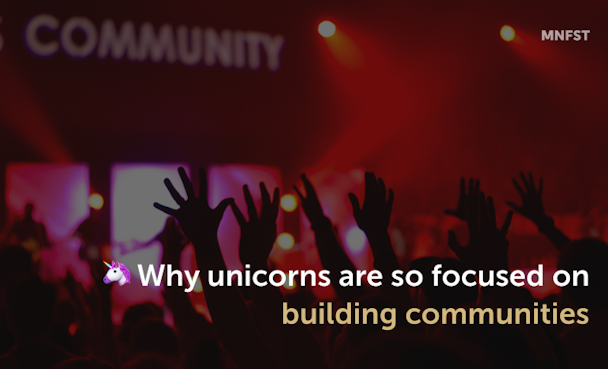Why unicorn brands are so focused on building communities
Traditional digital marketing strategies fall flat in the age of ad blockers and brand over-saturation. Meanwhile, competition gets tougher and customer acquisition costs go up. The modern digital economy requires a unique approach to marketing. That is why many of the most successful companies invest in things that don’t directly lead to more sales but strengthen the brand in the long run: they are focused on building communities around their product. It has become increasingly important for those brands that want to reach and engage with Gen Z.

MNFST
To become a movement
Having a strong community isn’t just a way to differentiate yourself — it’s a way to transcend the boundaries imposed by the core component of your business. No matter how good what you’re selling, at the end of the day it’s just a product. And one’s relationship with products can only get so personal.
According to the 2019 Meaningful Brands survey, 77% of brands could simply disappear and not a single customer would care. But if your marketing is structured around your community, your brand can avoid that fate. It can, instead, come to represent a passionate group of like-minded people.
To provide social context
Your community is a market positioning tool like no other. A lot of brands produce ads featuring sports cars and luxury items, trying to appeal to the target demographic’s ideal self-image. But in the grand scheme of things, it doesn’t mean much. By now we’re used to these tactics, that sell everything from skincare products to energy drinks. We all know that a new pair of shoes does not make one worthy of a Met Gala invitation — no matter what the ad wants you to believe. However, when your product is actually used by actual celebrities — this social context is impossible to ignore.
To gain brand ambassadors
Related to the last point — the people who feel ‘at home’ in your community are also most likely to convince others to use your product. Word-of-mouth marketing is a force to be reckoned with — even though you can’t easily measure it. 6 out of 10 customers won’t trust your brand unless someone else vouches for it. They want to be sure that you deliver on your promises. Content, generated by the members of your community, can convince them to take the risk.
Moreover, these same people will willingly expand effort to ‘convert’ others. Because, as we have previously mentioned, they perceive it as a movement, a lifestyle choice — not a purchasing decision. Their connections will become your leads — 71% of consumers are highly influenced by their friends’ recommendations.
To develop brand loyalty
Community loyalty often, though not necessarily, translates into brand loyalty. These people are brought together by your corporate vision, and will, as a rule, enthusiastically approach products that expand it. This can present a set of challenges: if your development decisions somehow damage the ideals your community was built upon, users will abandon your product en masse. However, if you stay true to your promises, people will be eager to try out new things.
To make smarter decisions
Having an active community is a great way to ensure a transparent feedback loop between you and your customers. Individual reactions get lost, but communal resonance is hard to miss. Your community can amplify the voices that would otherwise be drowned out.
It also gives you a great way to measure how well you’re doing as a company. You can use it as a metric for customer satisfaction and customer retention.
According to Accenture Interactive, 91% of Gen Z and millennials are willing to switch brands over ethical issues. If you monitor your communal spaces, you can notice the early signs of things going wrong. To speed this feedback loop further up, you can even directly address your customers in a public forum and listen to their grievances or suggestions.
Moreover, it’s far less expensive for a business to retain customers than it is to acquire new ones. Yet most companies continue to prioritise customer acquisition over retention.
To bridge online and offline
Last, but not least, it’s a great way to establish yourself on both sides of the screen by bringing your online community offline (or vice versa).
Your online community does not cease to exist in the real world. If you’re a company that makes digital products, or uses direct-to-consumer sales tactics, you can take advantage of this to establish your presence in meatspace.
Companies from Blizzard to Google and Coinbase arrange meet-ups and conferences, giving their community members an opportunity to convene in real life. The connections people make online are more tangible than they might seem and nurturing them offline will only make them stronger. Moreover, real world presence will work as advertising for people you’ve been unable to reach online.
Likewise, traditional brands can establish online communities so that their users, no matter where they live, get the opportunity to lead an active communal life.
Conclusion
Brand communities are a part of our digital culture — and you can’t ignore it. If you are not nurturing the communities of both your customers and your supply-side partners, you risk playing a losing game against the rising cost of traffic and clicks.
We need to open channels of communication through regular people, those we can truly connect to. Only they can reliably drive long term user retention. That’s why it is vital to focus on your social impact in addition to conventional marketing channels.


